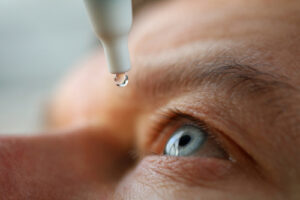Glaucoma is a serious eye condition that can lead to permanent vision loss if left untreated. Many people often refer to glaucoma as the “silent thief of sight” because it often progresses slowly and without noticeable symptoms until significant damage has already occurred.
Keep reading to learn more about glaucoma and why it is called the silent thief of sight, and what you can do to protect your vision!
What is Glaucoma?
Glaucoma is a group of eye conditions that damage the optic nerve. The optic nerve is responsible for transmitting visual information from the eye to the brain.

With such an important job, a healthy optic nerve is vital for clear and comprehensive vision. The most common type of glaucoma is primary open-angle glaucoma, which occurs when the drainage canals in the eye block fluid from leaving the eye, causing pressure to build up and damage the optic nerve.
Other types of glaucoma include angle-closure glaucoma, normal-tension glaucoma, and congenital glaucoma. The damage to the optic nerve usually occurs slowly in most types of glaucoma, with the exception of angle-closure glaucoma.
That means, in the majority of cases, vision damage will also occur slowly. Another thing that makes early vision loss associated with glaucoma less noticeable is the fact that the portion of the vision often first damaged by glaucoma is the peripheral vision.
What Is The Silent Thief of Sight?
One of the reasons why glaucoma is called the “silent thief of sight” is that it often progresses slowly and without noticeable symptoms until significant vision damage has already occurred. In the early stages of glaucoma, there may be no noticeable symptoms at all.
 As the condition progresses, however, people may begin to experience symptoms such as blurred vision, halos around lights, and loss of peripheral vision. Unfortunately, by the time these symptoms appear, significant damage to the optic nerve has already occurred, and the vision loss may be irreversible.
As the condition progresses, however, people may begin to experience symptoms such as blurred vision, halos around lights, and loss of peripheral vision. Unfortunately, by the time these symptoms appear, significant damage to the optic nerve has already occurred, and the vision loss may be irreversible.
This is why routine eye exams are important. Early detection and treatment are essential to avoid potential or further vision damage due to glaucoma or other eye conditions.
Your eye doctor at Blaine Eye Clinic can recognize the signs and changes inside the eye that indicate glaucoma and monitor these changes to ensure you are not at risk for vision loss. If further treatment is needed, your eye doctor at Blaine Eye Clinic may refer you to a glaucoma specialist.
What Are the Risk Factors for Glaucoma?

In addition to seeing your eye doctor for regular eye exams, it’s also important to know if you have some common risk factors for glaucoma. There are several risk factors for glaucoma, including age, family history, race, and certain medical conditions.
People over the age of sixty are at higher risk for glaucoma, as are people with a family history of the condition. African Americans and Hispanics are also at higher risk for glaucoma than Caucasians.
Other risk factors include having high eye pressure, thin corneas, and certain medical conditions such as diabetes and high blood pressure. Your eye doctor at Blaine Eye Clinic will weigh all of these factors to determine your risk for developing glaucoma.
Based on your risk factors, your eye doctor may recommend more frequent eye exams to ensure you are not at risk for vision loss.
Protecting Your Vision
While there is no cure for glaucoma, there are steps you can take to protect your vision and reduce your risk of developing the condition. The most important step is to get regular comprehensive eye exams, especially if you are over the age of sixty, have a family history of glaucoma, or have other risk factors for the condition.
 During a comprehensive eye exam, your eye doctor at Blaine Eye Clinic will measure your eye pressure, examine the optic nerve, and perform other tests to check for signs of glaucoma. If some of these tests show abnormal results, your doctor will schedule you for more in-depth testing.
During a comprehensive eye exam, your eye doctor at Blaine Eye Clinic will measure your eye pressure, examine the optic nerve, and perform other tests to check for signs of glaucoma. If some of these tests show abnormal results, your doctor will schedule you for more in-depth testing.
Your eye doctor will monitor the health of your eyes frequently, as there are no symptoms that would be noticeable to you in the early stages of glaucoma. It is important to follow your doctor’s treatment plan closely and to attend regular follow-up appointments to monitor your condition and adjust your treatment as needed.
In addition to regular eye exams and medical treatment, there are other steps you can take to protect your vision and reduce your risk of developing glaucoma.
These include maintaining a healthy diet and lifestyle, avoiding smoking and excessive alcohol consumption, protecting your eyes from injury, and managing other medical conditions that can increase your risk of glaucoma.
Blaine Eye Clinic Can Help You Preserve Your Vision
The best way to protect your vision and reduce your risk of developing glaucoma is to get regular comprehensive eye exams, especially if you are over the age of sixty, have a family history of the condition, or have other risk factors.
Are you experiencing vision changes or have a family history of glaucoma? Schedule an appointment at Blaine Eye Clinic in Blaine, MN, today!





